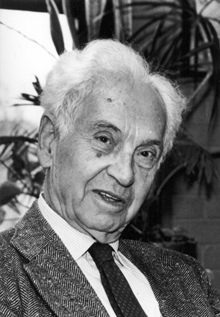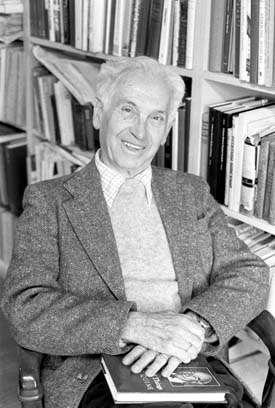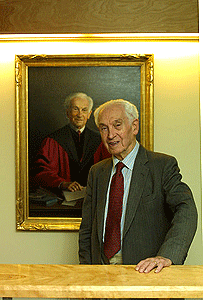<Back to Index>
- Evolutionary Biologist Ernst Walter Mayr, 1904
- Violinist and Composer Jan Kubelík, 1880
- Prime Minister of the Netherlands Willem Drees, 1886
PAGE SPONSOR



Ernst Walter Mayr (July 5, 1904 – February 3, 2005) was one of the 20th century's leading evolutionary biologists. He was also a renowned taxonomist, tropical explorer, ornithologist, historian of science, and naturalist. His work contributed to the conceptual revolution that led to the modern evolutionary synthesis of Mendelian genetics, systematics, and Darwinian evolution, and to the development of the biological species concept.
Neither Charles Darwin nor anyone else in his time knew the answer to the species problem: how multiple species could evolve from a single common ancestor. Ernst Mayr approached the problem with a new definition for the concept of species. In his book Systematics and the Origin of Species (1942) he wrote that a species is not just a group of morphologically similar individuals, but a group that can breed only among themselves, excluding all others. When populations within a species become isolated by geography, feeding strategy, mate selection, or other means, they may start to differ from other populations through genetic drift and natural selection, and over time may evolve into new species. The most significant and rapid genetic reorganization occurs in extremely small populations that have been isolated (as on islands).
His theory of peripatric speciation (a more precise form of allopatric speciation which he advanced), based on his work on birds, is still considered a leading mode of speciation, and was the theoretical underpinning for the theory of punctuated equilibrium, proposed by Niles Eldredge and Stephen Jay Gould. Mayr is sometimes credited with inventing modern philosophy of biology, particularly the part related to evolutionary biology, which he distinguished from physics due to its introduction of (natural) history into science. Mayr was the second son of Helene Pusinelli and Dr. Otto Mayr. His father was a jurist (District Prosecuting Attorney at Würzburg) but
took an interest in natural history and took the children out on field
trips. He learnt all the local birds in Würzburg from his elder
brother Otto. He also had access to a natural history magazine for
amateurs, Kosmos. His father died just before he was thirteen. The family then moved to Dresden and
he studied at the Staatsgymnasium (“Royal Gymnasium” until 1918) in
Dresden - Neustadt and completed his high school education there. In
April 1922, while still in high school, he joined the newly founded
Saxony Ornithologists’ Association. Here he met Rudolf Zimmermann, who
became his ornithological mentor. In February 1923, Mayr passed his
high school examination (Abitur) and his mother rewarded him with a
pair of binoculars. On March 23, 1923 on the lakes of Moritzburg, the Frauenteich, he spotted what he identified as a Red crested Pochard.
The species had not been seen in Saxony since 1845 and the local club
argued about the identity. Raimund Schelcher (1891 – 1979) of the club
then suggested that Mayr visit his classmate Erwin Stresemann on his way to Greifswald, where Mayr was to begin his medical studies. After
a tough interrogation, Stresemann accepted and published the sighting
as authentic. Stresemann was very impressed and suggested that, between
semesters, Mayr could work as a volunteer in the ornithological section
of the museum. Mayr wrote about this event, "It was as if someone had
given me the key to heaven." He entered the University of Greifswald in 1923 and, according to Mayr himself, "took the medical curriculum (to satisfy a family tradition)." Mayr
was endlessly interested in ornithology and "chose Greifswald at the
Baltic for my studies for no other reason than that... it was situated in the ornithologically most interesting area." Although he ostensibly planned to become a physician, he was "first and foremost an ornithologist." During
the first semester break Stresemann gave him a test to identify
treecreepers and Mayr was able to identify most of the specimens
correctly. Stresemann declared that Mayr 'was a born systematist'. In
1925 Stresemann suggested that he give up his medical studies and join
the Berlin Museum with the prospect of bird collecting trips to the
tropics on the condition that he completed his doctoral studies in 16
months. Mayr completed his doctorate in ornithology at the University of Berlin under
Dr. Carl Zimmer, who was a full professor (Ordentlicher Professor), on
June 24, 1926 at the age of 21. On July 1 he accepted the position
offered to him at the Museum for a monthly salary of 330.54 Reichsmark. At the International Zoological Congress at Budapest in 1927, Mayr was introduced by Stresemann to banker and naturalist Walter Rothschild, who asked him to undertake an expedition to New Guinea on behalf of himself and the American Museum of Natural History in
New York. In New Guinea, Mayr collected several thousand bird skins (he
named 26 new bird species during his lifetime) and, in the process also
named 38 new orchid species. During his stay in New Guinea, he was invited to accompany the Whitney South Seas Expedition to the Solomon Islands.
Also, while in New Guinea, he visited the Lutheran missionaries Otto
Thiele and Christian Keyser, in the Finschhafen district; there, while
in conversation with his hosts, he uncovered the discrepancies in Hermann Detzner's popular book, Four Years among the Cannibals in German Guinea from 1914 to the Truce, in which Detzner claimed to have seen the interior, discovered several
species of flora and fauna, while remaining only steps ahead of the
Australian patrols sent to capture him. He returned to Germany in 1930 and in 1931 he accepted a curatorial position at the American Museum of Natural History, where he played the important role of brokering and acquiring the Walter Rothschild collection
of bird skins, which was being sold in order to pay off a blackmailer.
During his time at the museum he produced numerous publications on bird
taxonomy, and in 1942 his first book, Systematics and the Origin of Species, which completed the evolutionary synthesis started by Darwin. After
Mayr was appointed at the American Museum of Natural History, he
influenced American ornithological research by mentoring young
birdwatchers. Mayr was surprised at the differences between American
and German birding societies. He noted that the German society was "far
more scientific, far more interested in life histories and breeding
bird species, as well as in reports on recent literature." Mayr
organized a monthly seminar under the auspices of the Linnean Society
of New York. Under the influence of J.A. Allen, Frank Chapman, and
Jonathan Dwight, the society concentrated on taxonomy and later became
a clearing house for bird banding and sight records. Mayr
encouraged his Linnaean Society seminar participants to take up a
specific research project of their own. Under Mayr's influence one of
them, Joseph Hickey, went on to write A Guide to Birdwatching (1943).
Hickey remembered later, "Mayr was our age and invited on all our field
trips. The heckling of this German foreigner was tremendous, but he
gave tit for tat, and any modern picture of Dr E. Mayr as a very formal
person does not square with my memory of the 1930s. He held his own." A
group of eight young birdwatchers from The Bronx later
became the Bronx County Bird Club, led by Ludlow Griscom. "Everyone
should have a problem" was the way one Bronx County Bird Club member
recalled Mayr's refrain. Mayr
said of his own involvement with the local birdwatchers: "In those
early years in New York when I was a stranger in a big city, it was the
companionship and later friendship which I was offered in the Linnean
Society that was the most important thing in my life." Mayr also greatly influenced the American ornithologist Margaret Morse Nice. Mayr encouraged her to correspond with European ornithologists and helped her in her landmark study on song sparrows. Nice wrote to Joseph Grinnell in 1932, trying to get foreign literature reviewed in the Condor:
"Too many American ornithologists have despised the study of the living
bird; the magazines and books that deal with the subject abound in
careless statements, anthropomorphic interpretations, repetition of
ancient errors, and sweeping conclusions from a pitiful array of
facts. ... in Europe the study of the living bird is taken
seriously. We could learn a great deal from their writing." Mayr
ensured that Nice could publish her two - volume Studies in the Life History of the Song Sparrow. He found her a publisher, and her book was reviewed by Aldo Leopold, Joseph Grinnell, and Jean Delacour. Nice dedicated her book to "My Friend Ernst Mayr." Mayr joined the faculty of Harvard University in 1953, where he also served as director of the Museum of Comparative Zoology from 1961 to 1970. He retired in 1975 as emeritus professor of zoology,
showered with honors. Following his retirement, he went on to publish
more than 200 articles, in a variety of journals; 14 of his 25
books were published after he was 65. Even as a centenarian, he continued to write books. On his 100th birthday, he was interviewed by Scientific American magazine. Mayr died on 3 February 2005 in his retirement home in Bedford, Massachusetts, after
a short illness. His wife, Margarete, died in 1990. He was survived by
two daughters, five grandchildren and 10 great - grandchildren. The awards that Mayr received include the National Medal of Science, the Balzan Prize, the Sarton Medal of the History of Science Society, the International Prize for Biology, the Loye and Alden Miller Research Award, and the Lewis Thomas Prize for Writing about Science. In 1939 he was elected a Corresponding Member of the Royal Australasian Ornithologists Union. He was awarded the Linnean Society of London's prestigious Darwin - Wallace Medal in 1958. For his work, Animal Species and Evolution, he was awarded the Daniel Giraud Elliot Medal from the National Academy of Sciences in 1967. Mayr won the 1999 Crafoord Prize.
It honors basic research in fields that do not qualify for Nobel Prizes
and is administered by the same organization as the Nobel Prize. Mayr was co-author of six global reviews of bird species new to science. Mayr was an atheist, stating "there is nothing that supports the idea of a personal God".
As a traditionally trained biologist with little
mathematical experience, Mayr was often highly critical of early mathematical approaches to evolution such as those of J.B.S. Haldane, famously calling in 1959 such approaches "beanbag genetics". He maintained that factors such as reproductive isolation had to be taken into account. In a similar fashion, Mayr was also quite critical of molecular evolutionary studies such as those of Carl Woese. In many of his writings, Mayr rejected reductionism in
evolutionary biology, arguing that evolutionary pressures act on the
whole organism, not on single genes, and that genes can have different
effects depending on the other genes present. He advocated a study of
the whole genome rather than of isolated genes only. Current molecular studies in evolution and speciation indicate that although allopatric speciation seems to be the norm in groups (such as in many invertebrates — especially in the insects), there are numerous cases of sympatric speciation in groups with greater mobility (such as the birds). After articulating the biological species concept in 1942, Mayr played a central role in the species problem debate over what was the best species concept. He staunchly defended the biological species concept against the many definitions of "species" that others proposed. Mayr was an outspoken defender of the scientific method,
and one known to sharply critique science on the edge. As a notable
recent example, he criticized the search for aliens as conducted by
fellow Harvard professor Paul Horowitz as being a waste of university and student resources, for its inability to address and answer a scientific question. Mayr rejected the idea of a gene centered view of evolution and starkly but politely criticized Richard Dawkins' ideas: The
funny thing is if in England, you ask a man in the street who the
greatest living Darwinian is, he will say Richard Dawkins. And indeed,
Dawkins has done a marvelous job of popularizing Darwinism. But
Dawkins' basic theory of the gene being the object of evolution is
totally non-Darwinian. I would not call him the greatest Darwinian. Mayr insisted throughout his career that the gene as the target of selection cannot and should not be considered a valid idea in modern evolutionary thought. The
idea that a few people have about the gene being the target of
selection is completely impractical; a gene is never visible to natural
selection, and in the genotype, it is always in the context with other
genes, and the interaction with those other genes make a particular
gene either more favorable or less favorable. In fact, Dobzhanksy, for instance, worked quite a bit on so-called lethal chromosomes which
are highly successful in one combination, and lethal in another.
Therefore people like Dawkins in England who still think the gene is
the target of selection are evidently wrong. In the 30s and 40s, it was
widely accepted that genes were the target of selection, because that
was the only way they could be made accessible to mathematics,
but now we know that it is really the whole genotype of the individual,
not the gene. Except for that slight revision, the basic Darwinian
theory hasn't changed in the last 50 years.